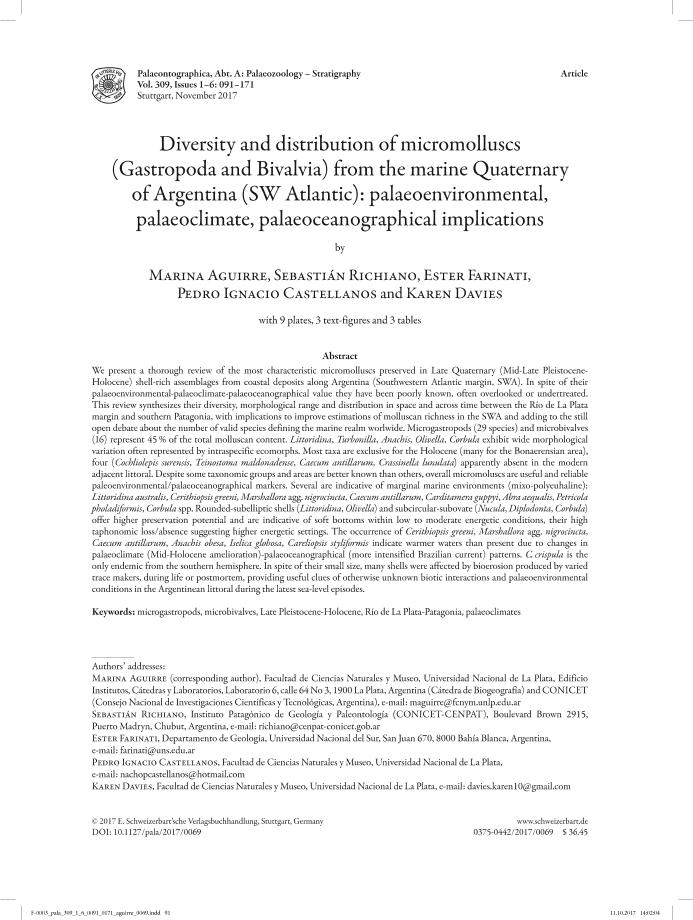Artículo
Diversity and distribution of micromolluscs (Gastropoda and Bivalvia) from the marine Quaternary of Argentina (SW Atlantic): Palaeoenvironmental, palaeoclimate, palaeoceanographical implications
Aguirre, Marina Laura ; Richiano, Sebastián Miguel
; Richiano, Sebastián Miguel ; Farinati, Ester Amanda; Castellanos, Pedro Ignacio; Davies, Karen
; Farinati, Ester Amanda; Castellanos, Pedro Ignacio; Davies, Karen
 ; Richiano, Sebastián Miguel
; Richiano, Sebastián Miguel ; Farinati, Ester Amanda; Castellanos, Pedro Ignacio; Davies, Karen
; Farinati, Ester Amanda; Castellanos, Pedro Ignacio; Davies, Karen
Fecha de publicación:
12/2017
Editorial:
E Schweizerbartsche Verlags
Revista:
Palaeontographica
ISSN:
0375-0442
Idioma:
Inglés
Tipo de recurso:
Artículo publicado
Clasificación temática:
Resumen
We present a thorough review of the most characteristic micromolluscs preserved in Late Quaternary (Mid-Late Pleistocene- Holocene) shell-rich assemblages from coastal deposits along Argentina (Southwestern Atlantic margin, SWA). In spite of their palaeoenvironmental-palaeoclimate-palaeoceanographical value they have been poorly known, often overlooked or undertreated. This review synthesizes their diversity, morphological range and distribution in space and across time between the Rio de La Plata margin and southern Patagonia, with implications to improve estimations of molluscan richness in the SWA and adding to the still open debate about the number of valid species defining the marine realm worlwide. Microgastropods (29 species) and microbivalves (16) represent 45 % of the total molluscan content. Littoridina, Turbonilla, Anachis, Olivella, Corbula exhibit wide morphological variation often represented by intraspecific ecomorphs. Most taxa are exclusive for the Holocene (many for the Bonaerensian area), four (Cochliolepis surensis, Teinostoma maldonadense, Caecum antillarum, Crassinella lunulata) apparently absent in the modern adjacent littoral. Despite some taxonomic groups and areas are better known than others, overall micromoluscs are useful and reliable paleoenvironmental/palaeoceanographical markers. Several are indicative of marginal marine environments (mixo-polyeuhaline): Littoridina australis, Cerithiopsis greeni, Marshallora agg. nigrocincta, Caecum antillarum, Carditamera guppyi, Abra aequalis, Petricola pholadiformis, Corbula spp. Rounded-subelliptic shells (Littoridina, Olivella) and subcircular-subovate (Nucula, Diplodonta, Corbula) offer higher preservation potential and are indicative of soft bottoms within low to moderate energetic conditions, their high taphonomic loss/absence suggesting higher energetic settings. The occurrence of Cerithiopsis greeni, Marshallora agg. nigrocincta, Caecum antillarum, Anachis obesa, Iselica globosa, Careliopsis styliformis indicate warmer waters than present due to changes in palaeoclimate (Mid-Holocene amelioration)-palaeoceanographical (more intensified Brazilian current) patterns. C. crispula is the only endemic from the southern hemisphere. In spite of their small size, many shells were affected by bioerosion produced by varied trace makers, during life or postmortem, providing useful clues of otherwise unknown biotic interactions and palaeoenvironmental conditions in the Argentinean littoral during the latest sea-level episodes.
Archivos asociados
Licencia
Identificadores
Colecciones
Articulos(CCT - LA PLATA)
Articulos de CTRO.CIENTIFICO TECNOL.CONICET - LA PLATA
Articulos de CTRO.CIENTIFICO TECNOL.CONICET - LA PLATA
Articulos(CCT-CENPAT)
Articulos de CTRO.CIENTIFICO TECNOL.CONICET - CENPAT
Articulos de CTRO.CIENTIFICO TECNOL.CONICET - CENPAT
Citación
Aguirre, Marina Laura; Richiano, Sebastián Miguel; Farinati, Ester Amanda; Castellanos, Pedro Ignacio; Davies, Karen; Diversity and distribution of micromolluscs (Gastropoda and Bivalvia) from the marine Quaternary of Argentina (SW Atlantic): Palaeoenvironmental, palaeoclimate, palaeoceanographical implications; E Schweizerbartsche Verlags; Palaeontographica; 309; 1-6; 12-2017; 91-171
Compartir
Altmétricas



